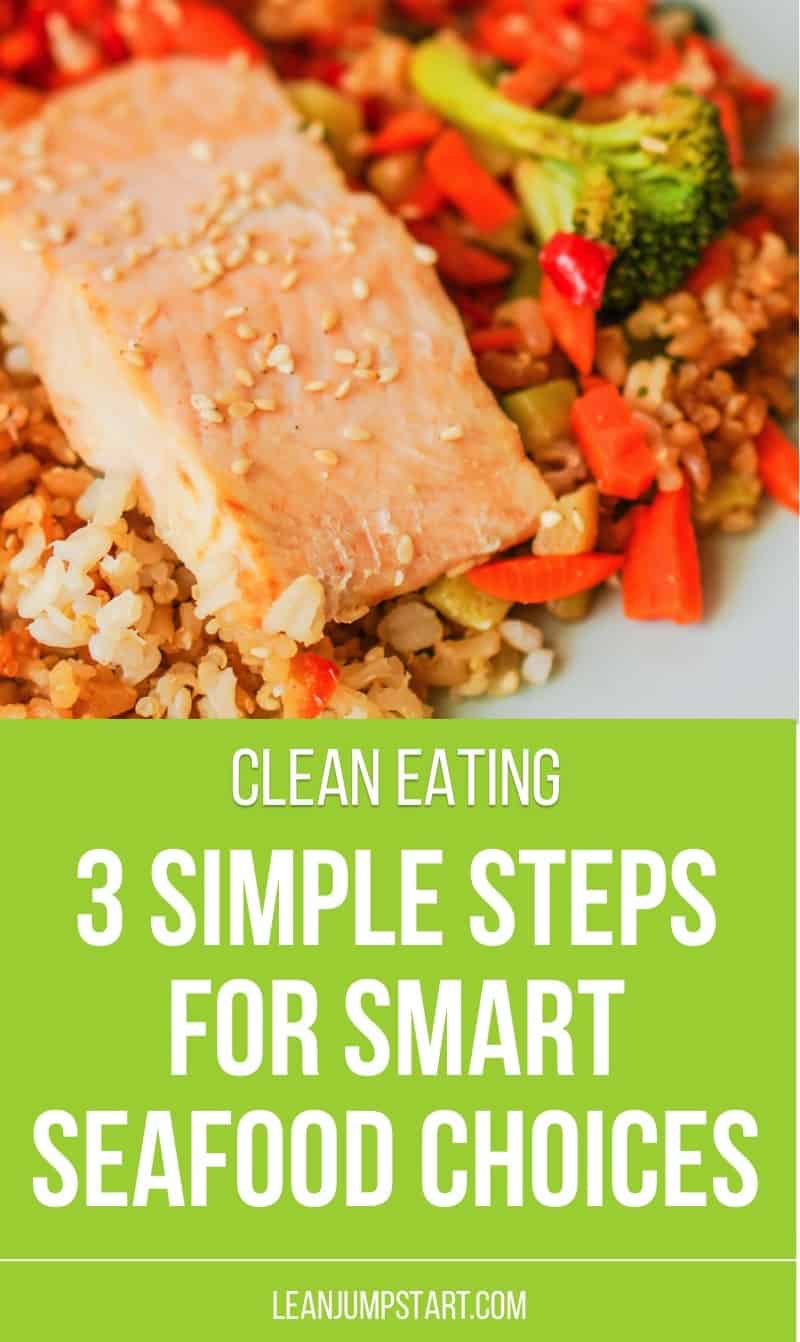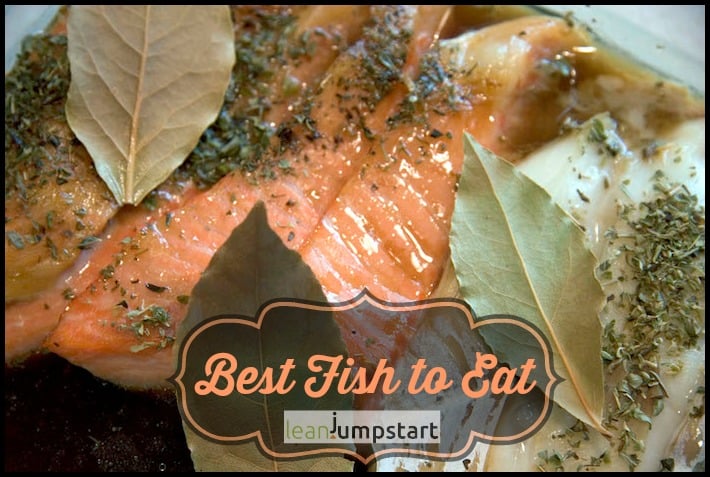Last Updated on February 4, 2019
What are the best fish to eat to support your clean eating habits? This week, I will give you some tips for simple and healthy fish recipes you can enjoy without guilt.
How to implement healthy fish recipes in your clean eating?
Are you looking for a healthy 80/20 approach that incorporates seafood? Remember, fish is high in omega-3s, those super important polyunsaturated fatty acids that your body cannot produce on its own. But could environmental pollutants cancel out that benefit?
Further, you might want to take into consideration the global overfishing phenomenon as well…
Health benefits of eating fish in general
First of all, seafood supplies high-quality protein that our body can easily digest. The tender meat also contains important vitamins and minerals, like the bone-friendly vitamin D. Saltwater fish delivers the needed iodine for our thyroid gland.
Fatty fish types, like herring or salmon, are rich in fish oil containing the above mentioned long chain omega-3 fatty acids. A sufficient supply of omega-3 fatty acids can prevent chronic inflammations such as psoriasis, rheumatism or arthritis and can even reduce the risk of allergies. Omega-3 fatty acids are also good for the cardiovascular, immune and nervous systems. In fact, research on omega-3s from the diet does indicate a lower risk of dying from brain or heart disease (1).
So it should not come as a surprise that nutrition experts recommend to eat at least 3-ounce servings (90-180 g) of fatty fish per week 1-2 times a week.
But what kinds of healthy fish can you eat without guilt?
Unfortunately, there is a massive overfishing problem globally. That means that people are taking far more fish out of the ocean than it can sustainably support. Therefore, some animal types are threatened with extinction and put on the red list… Otherwise…As a result of the rigorous U.S. management process, fish harvested in the U.S. is inherently sustainable.

How healthy is farmed seafood?
Farmed fish contains a lower ratio of omega-3 to omega-6 fatty acids, lower levels of protein and higher levels of total fat. On top of that, aquacultures frequently use antibiotics, fungicides or even dyes. If unsure, I highly recommend opting for “organic” farmed fish with an eco-label.
Wild salmon is one of the healthiest options
Here is how you can avoid eating too many pollutants. To make your life as easy as possible, I’ve already made a pre-selection for you. If you want to implement clean, protein-rich recipes in your weekly meal plan, just stick mainly with salmon. It meets two important criteria: It is the lowest in the level of mercury and the highest in omega-3 levels. Wild Alaskan salmon generally has very low levels of toxins.
Farmed salmon from Norway tends to be of better overall quality too. Further, salmon is pretty easy to prepare and it is versatile enough to create many delicious, protein-rich recipes.
Baby Steps: How to incorporate a healthy fish meal in your week
Below is a simple 3-step habit change that will help you automate your healthy fish consumption. Use your weekly meal planning as a trigger.
- Research some simple clean eating salmon recipes or other low-risk seafood recipes (see alternatives below). When cooking seafood, always opt for lean preparation methods, like steaming, sautéing, baking, grilling, boiling or pouching. I especially love baked recipes, grilled fish tacos or fish soup. Another yummy idea is to add salmon (or other healthy fish) to a big salad instead of the typical chicken breast or mini-steaks. Eat seafood only natural without bread coating, crust or fatty sauce.
Here is a yummy recipe suggestion: steamed salmon with quinoa spinach. - Include one healthy, low-risk fish dish in your meal plan once per week. Write down any ingredients you need for your recipe on your customized shopping list.
- Write down any ingredients you need for your healthy protein rich meal on your customized shopping list.
Healthy salmon alternatives
As always- variation is key! Anchovies, herrings or sardines are other low-risk seafood choices. You could toss each of them over an easy salad mix. But also farmed freshwater rainbow trout could be a wonderful choice if you can get it.
If your weekly intake of fish stays fairly restricted you might want to vary sometimes with the affordable “medium mercury” codfish. Click here for yummy Cod Fish Recipes.
Cod vs salmon
Which one you prefer really depends on your priorities and health condition. Considering certain factors such as saturated fat content, calories, and price, cod may seem to be better for your budget and weight management. If you are however more focused on increasing your intake of good fats (omega 3 fatty acids) and folate while keeping the level of mercury low, then salmon is a better choice.
And what about tuna?
Canned albacore tuna is the so-cheap-its-crazy source of protein but not among my selection of best fish to eat although we would have some room to include it with our 80/20 clean eating approach. I’ve even published an easy recipe: tuna casserole with zoodles
To avoid high levels of mercury, try to replace it with canned salmon from time to time as it is an even more potent source of those crucial fatty acids (and it has less mercury).
Tip: Aldi offers affordable wild caught canned Alaskan salmon.
Which seafood you should avoid
Typical species high in mercury are marlin, king mackerel, swordfish, orange roughy, shark, swordfish, ahi tuna, filefish, and bigeye.
Check the most up to date data
Are you concerned about mercury and other contaminants in your seafood? Check the Environment Protection Agency (EPA) website for the most up-to-date data regarding contaminant levels of seafood in your region (United States).
How to recognize fresh foods
That’s easy: fresh fish doesn’t smell! It may have a subtle odor, but it must in no case smell overly fishy or rancid. The bad smell associated with fish is provoked by substances that result partly from the dismantling of protein. The longer the fish is stored, the more protein is decomposed. If you are buying a whole fish, please pay attention at the following signs of freshness:
- The eyes should be clear, not milky
- The skin should be shining and covered by a transparent coating
- The gills should be light red, not brownish
It is much harder to evaluate a fillet. A fresh fillet shines, doesn’t smell and doesn’t show any yellowish, frayed edges.
Tip: Prepare your fish the day you have bought it.
Is frozen fish healthy too?
Absolutely. The fish I buy most often is frozen, wild-caught Alaskan salmon. Often, fishermen gut their catches directly on board the same day and freeze it.
In that case, the frozen fish is of excellent quality. The only caveat – it might be a bit more firm than the fresh variation. Remember to defrost your filet in your fridge!
Money saving tip at Wholefoods: You can save over 50% when you skip the fresh fish counter and purchase instead of the Whole Catch frozen wild Alaskan sockeye salmon.
What to do if you can’t eat fish?
If you can’t eat seafood you may want to get your omega-3s directly from algae. Fact is, fish are only the “middle men”, which you can easily skip. Did you know that fish get their omega 3-s from a single celled algae called schizochytrium, that floats in the ocean?
These schizochytrium algae do not require light and nourish themselves from plant remains. To ensure that they still grow, these algae synthesize large amounts of omega-3 fatty acids DHA and EPA on their own.
Especially pregnant women should not underestimate the positive effects omega 3-s have for the development of their baby.
I’D LOVE TO HEAR FROM YOU!
Share with us below your thoughts regarding your best fish to eat or your favorite clean eating recipes!




Do you soak the fish in salt water before you fix them or freeze them?